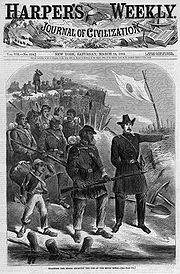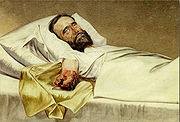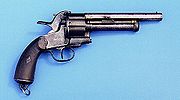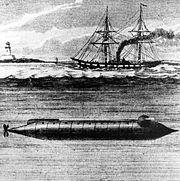
French weapons in the American Civil War
Encyclopedia
French weapons in the American Civil War had a key role in the conflict and encompassed most of the sectors of weaponry of the American Civil War
(1861–1865), from artillery
to firearms, submarines and ironclad warships. The effect of French
weapons was especially significant in field artillery and infantry
. These weapons were either American productions based on French designs, or sometimes directly imported from France.
 The "canon obusier de 12
The "canon obusier de 12
", introduced in the French Army
1853, an early type of "canon obusier
", or gun howitzer
developed during the reign of Napoleon III, was the primary cannon used in the American Civil War
, under the name of "12-pounder Napoleon Model 1857". Over 1,100 such Napoleons were manufactured by the North, and 600 by the South.
 The twelve-pound cannon "Napoleon" was the most popular smoothbore cannon used during the war. It was widely admired because of its safety, reliability, and killing power, especially at close range. It did not reach America until 1857. It was the last cast bronze
The twelve-pound cannon "Napoleon" was the most popular smoothbore cannon used during the war. It was widely admired because of its safety, reliability, and killing power, especially at close range. It did not reach America until 1857. It was the last cast bronze
gun used by an American army. The Federal
version of the Napoleon can be recognized by the flared front end of the barrel, called the muzzle swell. Confederate Napoleons were produced in at least six variations, most of which had straight muzzles, but at least eight cataloged survivors of 133 identified have muzzle swells. Additionally, four iron Confederate Napoleons produced by Tredegar Iron Works
in Richmond, Virginia
have been identified, of an estimated 125 cast.

 The Minié rifle
The Minié rifle
as well as the ammunition going with it, the Minié ball
, developed by the French Army captain Claude-Étienne Minié, was the most widely used firearms system of the American Civil War. The Minié system was also used extensively by various manufacturers, such as Springfield
, so that Springfield Model 1861
became most widely used rifle of the American Civil War.
The Minié ball produced terrible wounds on those struck in battle. The large-caliber
rounds easily shattered bones, and in many cases the attending surgeon simply amputated the limb rather than risk a typically fatal secondary infection
. The American Civil War, which often had many thousands of infantrymen armed with this type of ammunition, resulted in mass casualties on a scale which was inconceivable to contemporary strategists.

 During the American Civil War, the Union-built and French-designed submarine
During the American Civil War, the Union-built and French-designed submarine
Alligator
was the first U.S. Navy submarine and the first to feature compressed air (for air supply) and an air filtration system. Initially hand-powered by oars, it was converted after 6 months to a screw propeller powered by a hand crank. With a crew of 20, it was larger than Confederate submarines. Alligator was 47 feet (14.3 m) long and about 4 feet (1.2 m) in diameter. The submarine was lost in a storm off Cape Hatteras
on April 1, 1863 with no crew and under tow to its first combat deployment at Charleston.
 As the Confederacy struggled against the North, it attempted to purchase one of the latest ironclads from France, the Stonewall
As the Confederacy struggled against the North, it attempted to purchase one of the latest ironclads from France, the Stonewall
(later to be acquired by Japan after the end of the war). The ship, built in Bordeaux, France by the L'Arman shipyard in 1864, was an ironclad ram warship. However, the French government embargoed the sale of the ship to the Confederacy in February 1864 (prior to her launch in June 1864), and then sold the ship to the Royal Danish Navy
as the Stærkodder. However, L'Arman and the Danish Navy could not agree on a price for the ship, and sometime shortly after January 7, 1865 the vessel took on a Confederate
crew and was commissioned the CSS Stonewall while still at sea; L'Arman had secretly resold her to Confederacy.
The arrival of the "formidable" Stonewall in America was dreaded by the Union
, and several ships tried to intercept her, among them the USS Kearsarge
and the USS Sacramento
. In February and March, the USS Niagara
and the Sacramento
laid up at Ferrol, Spain, to prevent Stonewall from departing, but the much more powerful Confederate ship was able to make good her escape.
After an eventful crossing of the Atlantic Ocean, she eventually arrived in North American waters near the end of the American Civil War
, too late to have a significant effect. (By the time of her October 1864 commissioning the Confederacy was in disarray and near defeat, its navy disintegrating, along with most other Confederate institutions.) To avoid surrendering the vessel, Captain Page sailed her into Havana harbor and turned her over to the Captain General of Cuba for the sum of $16,000.
The vessel was then turned over to United States authorities in return for reimbursement of the same amount. She was temporarily de-commissioned, stationed at a US Navy dock, until she was offered for sale to the Japanese government of the Tokugawa shogunate
.
American Civil War
The American Civil War was a civil war fought in the United States of America. In response to the election of Abraham Lincoln as President of the United States, 11 southern slave states declared their secession from the United States and formed the Confederate States of America ; the other 25...
(1861–1865), from artillery
Artillery
Originally applied to any group of infantry primarily armed with projectile weapons, artillery has over time become limited in meaning to refer only to those engines of war that operate by projection of munitions far beyond the range of effect of personal weapons...
to firearms, submarines and ironclad warships. The effect of French
France
The French Republic , The French Republic , The French Republic , (commonly known as France , is a unitary semi-presidential republic in Western Europe with several overseas territories and islands located on other continents and in the Indian, Pacific, and Atlantic oceans. Metropolitan France...
weapons was especially significant in field artillery and infantry
Infantry
Infantrymen are soldiers who are specifically trained for the role of fighting on foot to engage the enemy face to face and have historically borne the brunt of the casualties of combat in wars. As the oldest branch of combat arms, they are the backbone of armies...
. These weapons were either American productions based on French designs, or sometimes directly imported from France.
Field Artillery

Canon obusier de 12
The Canon obusier de 12 , also known as the "Canon de l’Empereur" was a type of canon-obusier developed by France in 1853...
", introduced in the French Army
French Army
The French Army, officially the Armée de Terre , is the land-based and largest component of the French Armed Forces.As of 2010, the army employs 123,100 regulars, 18,350 part-time reservists and 7,700 Legionnaires. All soldiers are professionals, following the suspension of conscription, voted in...
1853, an early type of "canon obusier
Canon obusier
The Canon-obusier was a type of cannon developed by France in the 1850s. The canon-obusier was a smoothbore cannon using either shells, balls or canisters, and was therefore a vast improvement over previous cannon firing metal balls, such as the Gribeauval system.The very first canon-obusiers...
", or gun howitzer
Howitzer
A howitzer is a type of artillery piece characterized by a relatively short barrel and the use of comparatively small propellant charges to propel projectiles at relatively high trajectories, with a steep angle of descent...
developed during the reign of Napoleon III, was the primary cannon used in the American Civil War
American Civil War
The American Civil War was a civil war fought in the United States of America. In response to the election of Abraham Lincoln as President of the United States, 11 southern slave states declared their secession from the United States and formed the Confederate States of America ; the other 25...
, under the name of "12-pounder Napoleon Model 1857". Over 1,100 such Napoleons were manufactured by the North, and 600 by the South.

Bronze
Bronze is a metal alloy consisting primarily of copper, usually with tin as the main additive. It is hard and brittle, and it was particularly significant in antiquity, so much so that the Bronze Age was named after the metal...
gun used by an American army. The Federal
Union Army
The Union Army was the land force that fought for the Union during the American Civil War. It was also known as the Federal Army, the U.S. Army, the Northern Army and the National Army...
version of the Napoleon can be recognized by the flared front end of the barrel, called the muzzle swell. Confederate Napoleons were produced in at least six variations, most of which had straight muzzles, but at least eight cataloged survivors of 133 identified have muzzle swells. Additionally, four iron Confederate Napoleons produced by Tredegar Iron Works
Tredegar Iron Works
The Tredegar Iron Works was a historic iron foundry in Richmond, Virginia, United States of America, opened in 1837. During the American Civil War, the works served as the primary iron and artillery production facility of the Confederate States of America...
in Richmond, Virginia
Richmond, Virginia
Richmond is the capital of the Commonwealth of Virginia, in the United States. It is an independent city and not part of any county. Richmond is the center of the Richmond Metropolitan Statistical Area and the Greater Richmond area...
have been identified, of an estimated 125 cast.
Firearms


Minié rifle
The Minié rifle was an important rifle in the 19th century, developed in 1849 following the invention of the Minié ball in 1847 by the French Army captains Claude-Étienne Minié of the Chasseurs d'Orléans and Henri-Gustave Delvigne. The rifle was designed to allow rapid muzzle loading of rifles, an...
as well as the ammunition going with it, the Minié ball
Minié ball
The Minié ball is a type of muzzle-loading spin-stabilising rifle bullet named after its co-developer, Claude-Étienne Minié, inventor of the Minié rifle...
, developed by the French Army captain Claude-Étienne Minié, was the most widely used firearms system of the American Civil War. The Minié system was also used extensively by various manufacturers, such as Springfield
Springfield Armory
The Springfield Armory, located in the City of Springfield, Massachusetts - from 1777 until its closing in 1968 - was the primary center for the manufacture of U.S. military firearms. After its controversial closing during the Vietnam War, the Springfield Armory was declared Western Massachusetts'...
, so that Springfield Model 1861
Springfield Model 1861
The Springfield Model 1861 was a Minié-type rifled musket shoulder arm used by the United States Army and Marine Corps during the American Civil War. Commonly referred to as the "Springfield" , it was the most widely used U.S...
became most widely used rifle of the American Civil War.
The Minié ball produced terrible wounds on those struck in battle. The large-caliber
Caliber
In guns including firearms, caliber or calibre is the approximate internal diameter of the barrel in relation to the diameter of the projectile used in it....
rounds easily shattered bones, and in many cases the attending surgeon simply amputated the limb rather than risk a typically fatal secondary infection
Infection
An infection is the colonization of a host organism by parasite species. Infecting parasites seek to use the host's resources to reproduce, often resulting in disease...
. The American Civil War, which often had many thousands of infantrymen armed with this type of ammunition, resulted in mass casualties on a scale which was inconceivable to contemporary strategists.

Submarines

Submarine
A submarine is a watercraft capable of independent operation below the surface of the water. It differs from a submersible, which has more limited underwater capability...
Alligator
USS Alligator (1862)
The fourth United States Navy ship called Alligator is the first known U.S. Navy submarine, and was active during the American Civil War. The first American submarine, built in the Revolutionary War era, was the Turtle; however, this craft never served in the U.S...
was the first U.S. Navy submarine and the first to feature compressed air (for air supply) and an air filtration system. Initially hand-powered by oars, it was converted after 6 months to a screw propeller powered by a hand crank. With a crew of 20, it was larger than Confederate submarines. Alligator was 47 feet (14.3 m) long and about 4 feet (1.2 m) in diameter. The submarine was lost in a storm off Cape Hatteras
Cape Hatteras
Cape Hatteras is a cape on the coast of North Carolina. It is the point that protrudes the farthest to the southeast along the northeast-to-southwest line of the Atlantic coast of North America...
on April 1, 1863 with no crew and under tow to its first combat deployment at Charleston.
Ironclads

Japanese battleship Kotetsu
, later renamed was the first ironclad warship of the Imperial Japanese Navy. Built in France in 1864 for the Confederate States Navy, and acquired from the United States in February 1869, she was an ironclad ram warship...
(later to be acquired by Japan after the end of the war). The ship, built in Bordeaux, France by the L'Arman shipyard in 1864, was an ironclad ram warship. However, the French government embargoed the sale of the ship to the Confederacy in February 1864 (prior to her launch in June 1864), and then sold the ship to the Royal Danish Navy
Royal Danish Navy
The Royal Danish Navy is the sea-based branch of the Danish Defence force. The RDN is mainly responsible for maritime defence and maintaining the sovereignty of Danish, Greenlandic and Faroese territorial waters...
as the Stærkodder. However, L'Arman and the Danish Navy could not agree on a price for the ship, and sometime shortly after January 7, 1865 the vessel took on a Confederate
Confederate States Navy
The Confederate States Navy was the naval branch of the Confederate States armed forces established by an act of the Confederate Congress on February 21, 1861. It was responsible for Confederate naval operations during the American Civil War...
crew and was commissioned the CSS Stonewall while still at sea; L'Arman had secretly resold her to Confederacy.
The arrival of the "formidable" Stonewall in America was dreaded by the Union
Union (American Civil War)
During the American Civil War, the Union was a name used to refer to the federal government of the United States, which was supported by the twenty free states and five border slave states. It was opposed by 11 southern slave states that had declared a secession to join together to form the...
, and several ships tried to intercept her, among them the USS Kearsarge
USS Kearsarge (1861)
USS Kearsarge, a Mohican-class sloop-of-war, is best known for her defeat of the Confederate commerce raider CSS Alabama during the American Civil War. The Kearsarge was the only ship of the United States Navy named for Mount Kearsarge in New Hampshire...
and the USS Sacramento
USS Sacramento (1862)
The first USS Sacramento was a sloop-of-war in the United States Navy.Sacramento was launched on 28 April 1862 at the Portsmouth Navy Yard, in Kittery, Maine; sponsored by a Mrs. Tilton of Boston; and commissioned on 7 January 1863, Commander Andrew E. K...
. In February and March, the USS Niagara
USS Niagara (1855)
The second USS Niagara was a steam frigate in the United States Navy.Niagara was launched by New York Navy Yard on 23 February 1855; sponsored by Miss Annie C. O'Donnell; and commissioned on 6 April 1857, Captain William L...
and the Sacramento
USS Sacramento (1862)
The first USS Sacramento was a sloop-of-war in the United States Navy.Sacramento was launched on 28 April 1862 at the Portsmouth Navy Yard, in Kittery, Maine; sponsored by a Mrs. Tilton of Boston; and commissioned on 7 January 1863, Commander Andrew E. K...
laid up at Ferrol, Spain, to prevent Stonewall from departing, but the much more powerful Confederate ship was able to make good her escape.
After an eventful crossing of the Atlantic Ocean, she eventually arrived in North American waters near the end of the American Civil War
Conclusion of the American Civil War
This is a timeline of the conclusion of the American Civil War which includes important battles, skirmishes, raids and other events of 1865. These led to additional Confederate surrenders, key Confederate captures, and disbandments of Confederate military units that occurred after Gen. Robert E...
, too late to have a significant effect. (By the time of her October 1864 commissioning the Confederacy was in disarray and near defeat, its navy disintegrating, along with most other Confederate institutions.) To avoid surrendering the vessel, Captain Page sailed her into Havana harbor and turned her over to the Captain General of Cuba for the sum of $16,000.
The vessel was then turned over to United States authorities in return for reimbursement of the same amount. She was temporarily de-commissioned, stationed at a US Navy dock, until she was offered for sale to the Japanese government of the Tokugawa shogunate
Tokugawa shogunate
The Tokugawa shogunate, also known as the and the , was a feudal regime of Japan established by Tokugawa Ieyasu and ruled by the shoguns of the Tokugawa family. This period is known as the Edo period and gets its name from the capital city, Edo, which is now called Tokyo, after the name was...
.

